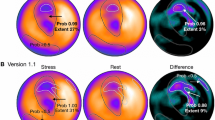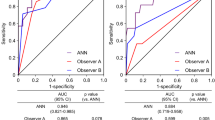Abstract
Background
The purpose of this study is to develop and analyze an open-source artificial intelligence program built on artificial neural networks that can participate in and support the decision making of nuclear medicine physicians in detecting coronary artery disease from myocardial perfusion SPECT (MPS).
Methods and Results
Two hundred and forty-three patients, who had MPS and coronary angiography within three months, were selected to train neural networks. Six nuclear medicine residents, one experienced nuclear medicine physician, and neural networks evaluated images of 65 patients for presence of coronary artery stenosis. Area under the curve (AUC) of receiver operating characteristics analysis for networks and expert was .74 and .84, respectively. The AUC of the other physicians ranged from .67 to .80. There were no significant differences between expert, neural networks, and standard quantitative values, summed stress score and total stress defect extent.
Conclusions
The open-source neural networks developed in this study may provide a framework for further testing, development, and integration of artificial intelligence into nuclear cardiology environment.
Similar content being viewed by others
References
Cross SS, Harrison RF, Kennedy RL. Introduction to neural networks. Lancet 1995;346:1075-9.
Awai K, Murao K, Ozawa A, Nakayama Y, Nakaura T, Liu D, et al. Pulmonary nodules: Estimation of malignancy at thin-section helical CT—effect of computer-aided diagnosis on performance of radiologists. Radiology 2006;239:276-84.
Petrick N, Haider M, Summers RM, Yeshwant SC, Brown L, Iuliano EM, et al. CT colonography with computer-aided detection as a second reader: Observer performance study. Radiology 2008;246:148-56.
Lindahl D, Lanke J, Lundin A, Palmer J, Edenbrandt L. Improved classifications of myocardial bull’s-eye scintigrams with computer-based decision support system. J Nucl Med 1999;40:96-101.
Ohlsson M. WeAidU-a decision support system for myocardial perfusion images using artificial neural networks. Artif Intell Med 2004;30:49-60.
Garcia EV, Cooke CD, Folks RD, Santana CA, Krawczynska EG, De Braal L, et al. Diagnostic performance of an expert system for the interpretation of myocardial perfusion SPECT studies. J Nucl Med 2001;42:1185-91.
Frigo M, Johnson SG. The design and implementation of FFTW3. Proc IEEE 2005;93:216-31.
Ingo Mierswa MS, Wurst M. YALE: Rapid prototyping for complex data mining tasks. In: 12th ACM SIGKDD International PONZETTO & STRUBE Conference on Knowledge Discovery and Data Mining; 2006.
Hall M, Frank E, Holmes G, Pfahringer B, Reutemann P, Witten I. The WEKA data mining software. ACM SIGKDD Explor Newslett (ACM Digital Library) 2009;11:10-8.
Hanley JA, McNeil BJ. A method of comparing the areas under receiver operating characteristic curves derived from the same cases. Radiology 1983;148:839-43.
Germano G, Kavanagh PB, Waechter P, Areeda J, Van Kriekinge S, Sharir T, et al. A new algorithm for the quantitation of myocardial perfusion SPECT. I: Technical principles and reproducibility. J Nucl Med 2000;41:712-9.
Slomka PJ, Nishina H, Berman DS, Akincioglu C, Abidov A, Friedman JD, et al. Automated quantification of myocardial perfusion SPECT using simplified normal limits. J Nucl Cardiol 2005;12:66-77.
Garcia EV, Faber TL, Cooke CD, Folks RD, Chen J, Santana C. The increasing role of quantification in clinical nuclear cardiology: The Emory approach. J Nucl Cardiol 2007;14:420-32.
Garcia EV, DePuey EG, DePasquale EE. Quantitative planar and tomographic thallium-201 myocardial perfusion imaging. Cardiovasc Intervent Radiol 1987;10:374-83.
Ficaro EP, Kritzman JN, Corbett JR. Development and clinical validation of normal Tc-99m sestamibi database: Comparison of 3D-MSPECT to CEqual. J Nucl Med 1999;40:506.
Kritzman JN, Ficaro EF, Liu YH, Wackers FJT, Corbett JR. Evaluation of 3-D MSPECT for quantification of Tc-99m sestamibi defect size. J Nucl Med 1999;40:817.
Wolak A, Slomka PJ, Fish MB, Lorenzo S, Acampa W, Berman DS, et al. Quantitative myocardial-perfusion SPECT: Comparison of three state-of-the-art software packages. J Nucl Cardiol 2008;15:27-34.
Fujita H, Katafuchi T, Uehara T, Nishimura T. Application of artificial neural network to computer-aided diagnosis of coronary artery disease in myocardial SPECT bull’s-eye images. J Nucl Med 1992;33:272-6.
Porenta G, Dorffner G, Kundrat S, Petta P, Duitschedlmayer J, Sochor H. Automated interpretation of planar thallium-201-dipyridamole stress-redistribution scintigrams using artificial neural networks. J Nucl Med 1994;35:2041-7.
Toft J, Hesse B, Rabol A, Carstensen S, Ali S. Myocardial sestamibi single-photon emission tomography: Variations in reference values with gender, age and rest versus stress? Eur J Nucl Med 1997;24:409-14.
Lindahl D, Toft J, Hesse B, Palmer J, Ali S, Lundin A, et al. Scandinavian test of artificial neural network for classification of myocardial perfusion images. Clin Physiol 2000;20:253-61.
Scott JA, Aziz K, Yasuda T, Gewirtz H. Integration of clinical and imaging data to predict the presence of coronary artery disease with the use of neural networks. Coron Artery Dis 2004;15:427-34.
Tagil K, Underwood SR, Davies G, Latus KA, Ohlsson M, Gotborg CW, et al. Patient gender and radiopharmaceutical tracer is of minor importance for the interpretation of myocardial perfusion images using an artificial neural network. Clin Physiol Funct Imaging 2006;26:146-50.
Haraldsson H, Ohlsson M, Edenbrandt L. Value of exercise data for the interpretation of myocardial perfusion SPECT. J Nucl Cardiol 2002;9:169-73.
Allison JS, Heo JY, Iskandrian AE. Artificial neural network modeling of stress single-photon emission computed tomographic imaging for detecting extensive coronary artery disease. Am J Cardiol 2005;95:178-81.
Lindahl D, Palmer J, Ohlsson M, Peterson C, Lundin A, Edenbrandt L. Automated interpretation of myocardial SPECT perfusion images using artificial neural networks. J Nucl Med 1997;38:1870-5.
Lomsky M, Gjertsson P, Johansson L, Richter J, Ohlsson M, Tout D, et al. Evaluation of a decision support system for interpretation of myocardial perfusion gated SPECT. Eur J Nucl Med Mol Imaging 2008;35:1523-9.
Kurgan LA, Cios KJ, Tadeusiewicz R, Ogiela M, Goodenday LS. Knowledge discovery approach to automated cardiac SPECT diagnosis. Artif Intell Med 2001;23:149-69.
Khorsand A, Haddad M, Graf S, Moertl D, Sochor H, Porenta G. Automated assessment of dipyridamole 201Tl myocardial SPECT perfusion scintigraphy by case-based reasoning. J Nucl Med 2001;42:189-93.
Cios KJ, Teresinska A, Konieczna S, Potocka J, Sharma S. A knowledge discovery approach to diagnosing myocardial perfusion. IEEE Eng Med Biol Mag 2000;19:17-25.
Haddad M, Adlassnig KP, Porenta G. Feasibility analysis of a case-based reasoning system for automated detection of coronary heart disease from myocardial scintigrams. Artif Intell Med 1997;9:61-78.
Khorsand A, Graf S, Sochor H, Schuster E, Porenta G. Automated assessment of myocardial SPECT perfusion scintigraphy: A comparison of different approaches of case-based reasoning. Artif Intell Med 2007;40:103-13.
Ezquerra N, Mullick R, Cooke CD, Krawczynska EG, Garcia EV. PERFEX—an expert-system for interpreting 3D myocardial perfusion. Expert Syst Appl 1993;6:459-68.
Robert MB, Yehuda K. Lessons from the Netflix prize challenge. SIGKDD Explor Newslett 2007;9:75-9.
Maddahi J, Van Train K, Prigent F, Garcia EV, Friedman J, Ostrzega E, et al. Quantitative single photon emission computed thallium-201 tomography for detection and localization of coronary artery disease: Optimization and prospective validation of a new technique. J Am Coll Cardiol 1989;14:1689-99.
Acknowledgments
We would like to thank residents of the Department of Nuclear Medicine, Dr Unal, Dr Cakir, Dr Sucak, Dr Doksoz, and Dr Sahiner who have participated in the experiments of this study.
Author information
Authors and Affiliations
Corresponding author
Rights and permissions
About this article
Cite this article
Guner, L.A., Karabacak, N.I., Akdemir, O.U. et al. An open-source framework of neural networks for diagnosis of coronary artery disease from myocardial perfusion SPECT. J. Nucl. Cardiol. 17, 405–413 (2010). https://doi.org/10.1007/s12350-010-9207-5
Received:
Accepted:
Published:
Issue Date:
DOI: https://doi.org/10.1007/s12350-010-9207-5




